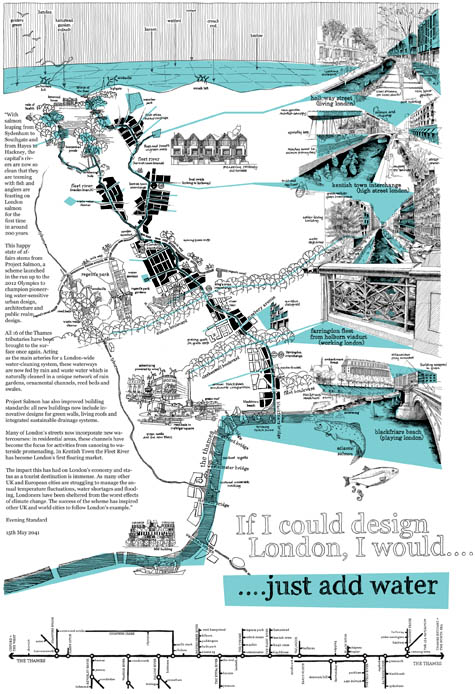Just Add Water
 [Image: EDAW's "If I could design London, I would... just add water"; view larger!].
[Image: EDAW's "If I could design London, I would... just add water"; view larger!].Having been interested in the riverine nature of London for years now – not many people realize that it's a city of canals – when I stumbled on a poster produced by EDAW for an exhibition last summer called "If I could design London I would...," I was excited enough to print it out and pin it up on my wall here at BLDGBLOG Centraal.
Now that I'm moving apartments – again – and have been forced to take the poster down, I decided I should actually write something about it.
 [Image: A close-up of EDAW's "If I could design London, I would... just add water"].
[Image: A close-up of EDAW's "If I could design London, I would... just add water"].Using the trope of a fake newspaper article – supposedly published in the Evening Standard in the year 2041 A.D. – EDAW, a surprisingly interesting firm, I might add, write the following scenario. I'll quote the whole thing, in fact, as I don't believe it's been published elsewhere online, and it's an interesting example of fictional narrative put in the service of urban design:
- With salmon leaping from Sydenham to Southgate and from Hayes to Hackey, the capital's rivers are now so clean that they are teeming with fish and anglers are feasting on London salmon for the first time in around 200 years.
This happy state of affairs stems from Project Salmon, a scheme launched in the run up to the 2012 Olympics to champion pioneering water-sensitive urban design, architecture and public realm design.
All 16 of the Thames tributaries have been brought to the surface once again. Acting as the main arteries for a London-wide water-cleaning system, these waterways are now fed by rain and waste water which is naturally cleaned in a unique network of rain gardens, ornamental channels, reed beds and swales.
Project Salmon has also improved building standards: all new buildings now include innovative designs for green walls, living roofs and integrated sustainable drainage systems.
Many of London's streets now incorporate new watercourses: in residential areas, these channels have become the focus for activities from canoeing to waterside promenading. In Kentish Town the Fleet River has become London's first floating market.
The impact this has had on London's economy and status as a tourist destination is immense. As many other UK and European cities are struggling to manage the annual temperature fluctuations, water shortage and flooding, Londoners have been sheltered from the worst effects of climate change. The success of the scheme has inspired other UK and world cities to follow London's example.
It's idyllic, sure, but it's no mere flight of fancy: the city is flooding, slowly but surely, over the course of coming centuries. Like it or not, in less time than now exists between us and Shakespeare, our descendants will be living in a London underwater: architects and urban designers – and, for that matter, novelists – might as well start planning now.
EDAW's project, and nearly two dozen others, can still be downloaded, a year after the fact, from Building Design.





Comments are moderated.
If it's not spam, it will appear here shortly!
La Serenissima-upon-Thames
i saw something on the history or discovery channel, possible 'cities of the underworld,' that investigated the complicated nature of the constant battle city engineers encounter in keeping the city from drowning. i think that's something you'd never think about most times at street level.
The poster seems to be trapped in a private account at Flickr; can't find it elsewhere. Could you please provide another link?
thanks!
what a great graphic!
reminds me of all the talk we have here in berkeley about daylighting strawberry creek downtown. if i could design berkeley, i too would just add water.
We are in the City of Vancouver BC, a city that only 100 years ago had 57 creeks brimming with wild salmon and surrounded by 1000 year old conifers. Humans have a short memory. You would be hard pressed to talk to anyone in planning about this. The city is covered in roads now and that's what important. And soccer fields with mile of grass. We are a pretty green city, but we have a ways to go. Blue is important too and awareness about water and watersheds is not great. Check our website: http://www.falsecreekwatershed.org
Celia
You might enjoy this essay by G.K. Chesterton on London and flooding...
"I feel an almost savage envy on hearing that London has been flooded in my absence, while I am in the mere country. My own Battersea has been, I understand, particularly favoured as a meeting of the waters. Battersea was already, as I need hardly say, the most beautiful of human localities."
This is such an exciting idea and in fact the topic of our design project this semester. I am a 5th year architecture student and passionate environmentalist so it is great to see this as a world trend. I think it's important for everyone to realise that healthy water systems make for healthy social systems too.
I accidentally erased someone's comment while erasing someone else's comment spam - sorry about that. David said:
"Mostly unrelated, just posting this interesting piece on unbuilt towers in NY from the roaring 20s."
Post a Comment